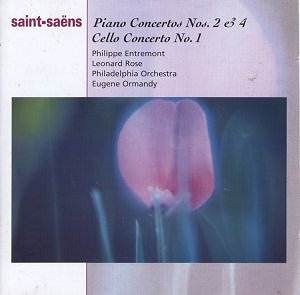Much of this material has been absent from the UK market for
many years so it’s good to be reacquainted with the virtues of the three
soloists, principally Entremont and Rose, with Zukerman bringing the recording
time up to snuff with the ubiquitous Introduction and Rondo Capriccioso
- which unlike the other three performances was not a Philadelphian product.
Entremont went on to record the complete set of the Saint-Saëns concertos
with the Toulouse Capitole Orchestra under the magnificent Fauré
conductor Michel Plasson – last on Sony Classical CD45624 which is a set
of the individual performances recorded, I believe, around the late 1970s.
So in a sense these Entremont-Ormandy performances of Concertos Nos 2
and 4 are in competition with Entremont’s later performances, though they’re
nearly twenty years earlier and spiced with the effervescent Cello Concerto.
The Bachian flourishes emerge as strongly rhetorical
in Entremont’s hands; he is adept and has a fine sense of the spaces
between the music. Ormandy meanwhile lavishes the full weight of the
Philadelphia sound on the cataclysmic opening orchestral tutti. This
it should be noted was recorded not in Philadelphia’s Town Hall but
whilst the orchestra was in New York and there is a sizeable decay of
sound in the Manhatten Centre which won’t be to all tastes. The woodwind
contributions are also very forward in the balance and an element of
aural artificiality pervades the recording to the musical detriment
of the performance. Entremont’s tone does tend to harden, especially
at fortissimo points, and whilst he is technically and musically sure
his tonal palette is rather limited, at least as preserved in these
recordings. He and Ormandy are certainly deadpan in their humour in
the second movement of the G Minor but lavish considerable virtuosity
on the tarantella-like finale which ends very well indeed. The C Minor
Concerto again opens utilizing baroque principles (a Chaconne) and affords
plenty of opportunities for power and quicksilver delicacy – the andante
section is particularly well shaped and for this credit must go as much
to Ormandy as to the pianist. I found some diffuseness in the second
of the two movements – this is superficially a two-movement work but
is multi-sectional and internally divided. Not all the subsidiary and
counter-themes are audible with as much clarity as they should be; but
I did like the way in which the glorious melody of the finale – a second
cousin of the "tune" in the Organ Symphony – is so sweepingly
and adroitly prepared and executed as also the ruminative piano and
bracing flautists and trumpets. The conclusion finds Ormandy in notably
forthright form.
The Cello Concerto brings to the fore one of America’s
greatest cellists, Leonard Rose. Woodwinds are dancing and again very
forward in the balance – the upfront CBS sound again, immediate and
confrontational – but Rose’s leanly focused tone copes and he deploys
a studied elegance to the Minuet-like passage that I find most attractive.
His colouration is discreet and technique quite adequate to deal with
Saint-Saens’ twists and turns, structurally and musically, and he ends
in triumph with a conclusive cadenza. Then there’s Zuckerman’s 1969
Introduction and Rondo Capriccioso with Mackerras – a delightful pendant
to an occasionally uneven but still attractive disc.
Jonathan Woolf


